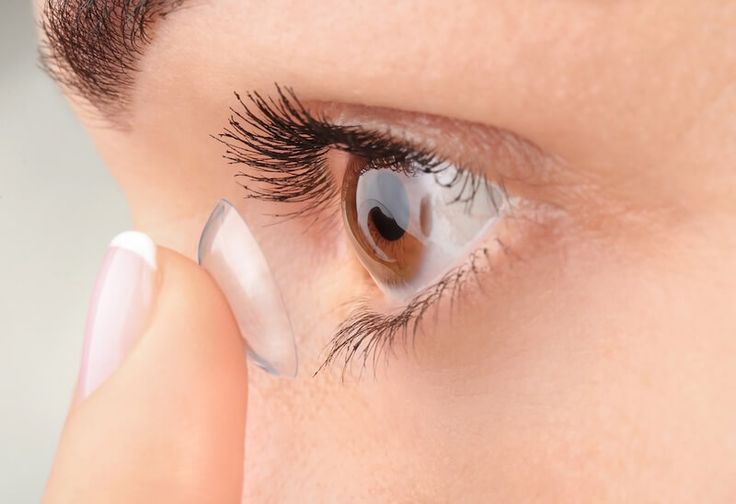Introduction

Wearing contact lenses properly helps protect the cornea and improve clear vision
For many people, contact lenses are a familiar companion that keeps their eyes bright and confident every time they go out. Yet, there’s one question that often sparks curiosity: “Is it okay to cry while wearing contact lenses?” Can tears damage your lenses or even harm your eye health?
This article will help you understand what happens when you cry while wearing contact lenses, the potential risks involved, and how to protect your eyes properly.
What Happens to Contact Lenses When You Cry?
Tears are a natural emotional and physiological response, often triggered by strong feelings, stress, or irritation. However, when you’re wearing contact lenses, that excess moisture can have a noticeable effect on the delicate lens resting on your cornea.
- Sudden Increase in Moisture
When you cry, the excessive tears can change the moisture balance between your lens and your eye surface. This shift may cause the lens to move slightly or even float temporarily on the tear film, leading to blurry or unstable vision.
- Reduced Adhesion
Excessive tearing can reduce the lens’s ability to adhere properly to the cornea. For some people, the lens might shift or even fall out—especially if they rub their eyes or wipe away tears frequently.
- Salt and Protein Residue in Tears
Tears naturally contain salts, lipids, and proteins. Prolonged crying can cause these components to accumulate on the lens surface, leading to irritation, dryness, or discomfort. Without proper cleaning, this buildup may also encourage bacterial growth and increase the risk of infection.
Is It Dangerous to Cry While Wearing Contact Lenses?

Crying while wearing contact lenses may irritate the eyes and cause lens displacement
Occasional tears won’t cause any serious harm. However, if you cry frequently while wearing lenses, or experience prolonged eye irritation, redness, or blurred vision, you should take extra care.
- Risk of Corneal Damage
During intense crying, the eyes blink and contract repeatedly, which may cause the lens to shift around the cornea. If the lens becomes misaligned or contaminated, it can rub against the cornea and lead to scratches or micro-abrasions—particularly dangerous since the cornea is highly sensitive.
- Infection or Inflammation
Tears can carry dust, bacteria, or other particles into the space between the lens and the eye. If your contact lenses aren’t clean, these contaminants may trigger conjunctivitis, keratitis, or other infections that cause temporary vision loss.
- Reduced Lens Lifespan
Frequent crying while wearing contact lenses can also reduce their lifespan. Protein deposits can make the lens cloudy, stiff, and less comfortable, leading to earlier replacement than expected.
What to Do If You Cry While Wearing Contact Lenses
If you find yourself in tears, don’t panic. Stay calm and follow these steps to protect your eyes:
Step 1: Stay still and avoid rubbing your eyes.
Let your tears flow naturally and resist the urge to touch or press on your eyelids, as this can dislodge or damage the lens.
Step 2: Gently dab away tears with a soft tissue.
Wipe only the outer cheek or eyelid area—never touch the eyeball itself.
Step 3: Check the lens position.
If your vision becomes blurry or you feel discomfort, the lens might have shifted. Wash your hands, look in the mirror, and gently adjust the lens using a clean, dry fingertip.
Step 4: Use artificial tears.
A few drops of preservative-free artificial tears can help rinse away salt and debris, soothing your eyes and restoring comfort.
Step 5: Remove the lenses if irritation persists.
If you continue to feel pain, burning, or blurred vision, remove your lenses immediately. Clean them with a proper lens solution and allow your eyes to rest for several hours.
How to Properly Clean and Store Contact Lenses

Clean and store contact lenses using proper solution to maintain healthy eyes
One of the main reasons for irritation after crying is improper cleaning and storage. To ensure eye safety, follow these hygiene rules:
- Always wash your hands thoroughly before touching your eyes or lenses.
- Use only approved cleaning and storage solutions—never tap water or homemade saline.
- Replace your lens solution daily and never reuse it.
- Clean your lens case at least once a week and replace it every three months.
- Follow the recommended replacement schedule—daily, bi-weekly, or monthly as advised.
These simple steps significantly reduce the risk of infection or irritation, even after emotional moments.
Tips to Keep Your Eyes Healthy When Wearing Contact Lenses
- Avoid wearing contact lenses when you expect to cry, such as during emotional events or movies.
- Carry a small contact lens kit and cleaning solution for emergencies.
- Never sleep with contact lenses on—it can block oxygen to your cornea and increase infection risk.
- Schedule regular eye exams every six months to monitor corneal health and lens fit.
When Should You Stop Wearing Contact Lenses?
If you often experience dryness, irritation, or stinging—even with proper care—consult an ophthalmologist. Some people develop what’s called “contact lens intolerance,” where the eyes gradually lose the ability to tolerate lenses. In such cases, your doctor may recommend alternative vision correction methods, such as Phakic ICLsurgery, a modern solution that restores clear vision without daily lens wear.
In short, crying is part of being human—but when you wear contact lenses, a little extra care goes a long way. Mild tears won’t harm your eyes, but if you feel discomfort or your vision blurs, take out your lenses, clean them carefully, and let your eyes rest. Healthy eyes need not only emotions but also mindful care every single day.

 vi
vi 27-Oct-2025
27-Oct-2025









 0916.741.763
0916.741.763 Appointment
Appointment